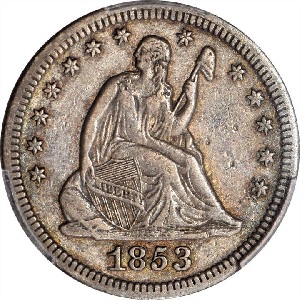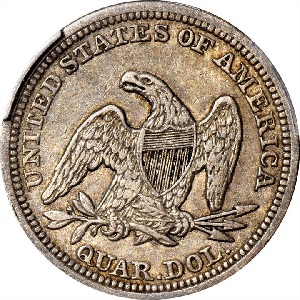1853 Seated Liberty Quarter, No Arrows or Rays
The discovery of California gold in 1848 set off a westward migration of fortune seekers. By the thousands, the "49ers" flooded the California gold fields in a mad rush. Within a few short years, the nation was awash in an abundance of gold.(1)
With a deluge of gold hitting the market, the price of silver increased relative to gold. As the value of silver climbed, it became profitable to melt silver coins because they were worth more than their face value. For example, in 1853, a U.S. quarter contained about 27 cents worth of silver. Under these circumstances, silver coins were pulled out of circulation in large numbers.
Mint Director George N. Eckert petitioned Congress to reduce the silver weight in circulating coins to make them worth slightly less than their face value, thus removing the incentive to melt them. Congress responded by passing the Mint Act of February 21, 1853.
The 1853 transition to lighter weight coinage was denoted by the addition of arrows straddling the date on half dimes and dimes, and arrows and the placement of rays around the eagle on quarters and half dollars. The rays were discontinued in 1854 but the arrows remained in the obverse designs through 1855.(2)
Before the law went into effect, 44,200 of the heavier quarters were struck at the Philadelphia Mint. Most of these were likely never released and melted down after the weight standard was changed.(3) The Philly Mint kicked into high gear and emitted more than 15 million 1853 Seated Liberty quarters WITH arrows and rays.(4)
There are an estimated 500 examples surviving today of the 1853 No Arrows quarters.(5) Compare this to the 5000 survivors of the 1853 Arrows quarters(6) and the divergence in collectability becomes obvious.
Fascinating Fact: One die pair was used to strike all 44,200 of the 1853 No Arrows or Rays quarters. The obverse die is characterized by the “53” digits punched twice into the date (apparently the engraver thought the digits were too low on the first try?). Because of the tremendous collector price difference between 1853 quarter varieties, forgers have tried to cash in by removing the arrows (and rays) from the lighter weight coin. One diagnostic used by experts to detect the fraud is none of the altered 1853 quarters have the repunched (sometimes called recut) date.(7)
The 1853 Seated Liberty No Arrows or Rays quarter is a smart acquisition in any condition. The historical value trends are among the finest in United Stated coin collecting.
| Estimated survivors in all grades: 500 ?
The survivor estimate from PCGS represents an average of one or more experts' opinions as to how many examples survive of a particular coin in all grades. Survival estimates include coins that are raw, certified by PCGS, and certified by other grading services. Learn more at PCGS. |
| PCGS Rarity Scale: 6.0 ?
The 'PCGS CoinFacts Rarity Scale' assesses the relative rarity of all U.S. coins, based on estimated surviving examples. The scale runs from 1.0 to 10.0. The higher the number, the rarer the coin.
Learn more at PCGS. |
| Click HERE to check for availability on eBay** |
review of eBay selection (don't forget to try the HERE link above):
 |
 |
| Trendline Avg = 19.49 | BETTER |
Historic Value Trend Charts:
| Last updated 4-8-25 | Return to Key Date Coin List | |
| Compare to Common Date Coin of Same Type | ||
|
|
||
| Download Charts to Your Computer | ||
Sources
1. Stack's Bowers Galleries. 1853/53 Liberty Seated Quarter. No Arrows. Aug 2015 Auction.
2. Heritage Auctions. 1853 25C No Arrows. Oct 2015 Auction.
3. Stack's Bowers Galleries. 1853 Liberty Seated Quarter. No Arrows. Nov 2014 Auction.
4. Heritage Auctions. 1853 25C No Arrows. Oct 2015 Auction.
5. PCGS. 1853 25C No Arrows (Regular Strike).
6. PCGS. 1853 25C Arrows and Rays (Regular Strike).
7. NGC. Counterfeit Detection: 1853 Seated Liberty Quarter. Oct 1, 2019.
**Many very fine coin dealers sell on eBay. At any point in time, there may be over one million search results for United States coins. This includes quite a few of the recommendations on our Key Date Coin List.
If you’re thinking about purchasing a rare coin, eBay is certainly worth a look. For your convenience, the links from this site to eBay are coded to bring up only coins certified by PCGS and NGC.
As is always, always the case, never buy a valuable coin from a seller whose trustworthiness cannot be verified. Learn more about this at our chapter Best Places to Buy Coins, which also has a section on doing business on eBay.
In the interest of full disclosure, Rare Coins 101 receives a small commission anytime someone connects to eBay from this site and purchases something.
Coin images by Stack's Bowers Galleries.


